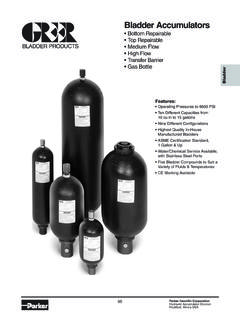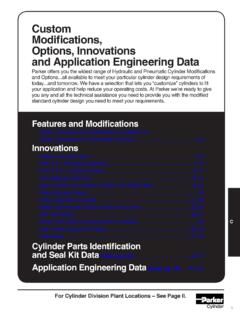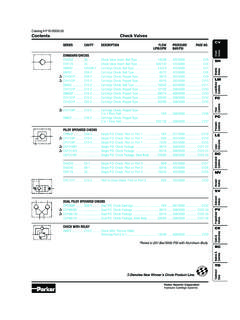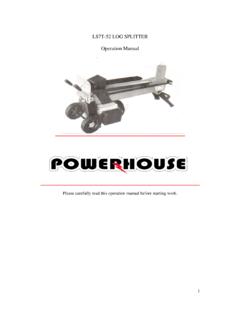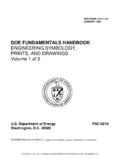Transcription of FLUID POWER GRAPHIC SYMBOLS - Fluid Power Solutions
1 FLUID POWER SymbolsFLUID POWER GRAPHIC SYMBOLSANSI GRAPHIC POWER systems are those that transmit and control POWER through use of a pressurized FLUID (liquid or gas) within an enclosed of SYMBOLS commonly used in drawing circuit diagrams for FLUID POWER systems are Pictorial, Cutaway, and GRAPHIC . These SYMBOLS are fully explained in the USA Standard Drafting Manual (Ref. 2). SYMBOLS are very useful for showing the interconnection of components. They are difficult to standardize from a functional SYMBOLS emphasize construction.
2 These SYMBOLS are complex to draw and the functions are not readily SYMBOLS emphasize the function and methods of operation of components. These SYMBOLS are simple to draw. Component functions and methods of operation are obvious. GRAPHIC SYMBOLS are capable of crossing language barriers, and can promote a universal understanding of FLUID POWER SYMBOLS for FLUID POWER systems should be used in conjunction with the GRAPHIC SYMBOLS for other systems published by the USA Standards Institute (Ref. 3 7 inclusive).
3 GRAPHIC SYMBOLS are those, which give symbolic representation of the component and all of its features pertinent to the circuit GRAPHIC SYMBOLS are stylized versions of the complete GRAPHIC SYMBOLS are an organization of simplified or complete SYMBOLS . Composite SYMBOLS usually represent a complex and This standard presents a system of GRAPHIC SYMBOLS for FLUID POWER forms of SYMBOLS are:CirclesRectanglesArcsDotsSquaresTria nglesArrowsCrossesSymbols using words or their abbreviations are avoided. SYMBOLS capable of crossing language barriers are presented function rather than construction is emphasized by the means of operating FLUID POWER components are shown as part of the symbol (where applicable).
4 Standard shows the basic SYMBOLS , describes the principles on which the SYMBOLS are based, and illustrates some representative composite SYMBOLS . Composite SYMBOLS can be devised for any FLUID POWER component by combining basic SYMBOLS are shown for commonly used standard provides basic SYMBOLS , which differentiate between hydraulic and pneumatic FLUID POWER purpose of this standard is to provide a system of FLUID POWER GRAPHIC SYMBOLS for industrial and educational purpose of this standard is to simplify Page 1 of 24 FLUID POWER Symbolsdesign, fabrication, analysis.
5 And service of FLUID POWER purpose of this standard is to provide FLUID POWER GRAPHIC SYMBOLS , which are internationally purpose of this standard is to promote universal understanding of FLUID POWER 2 of 24 FLUID POWER show connections, flow paths, and functions of components represented. They can indicate conditions occurring during transition from on flow path arrangement to another. SYMBOLS do not indicate construction, nor do they indicate values, such as pressure, flow rate, and other component do not indicate locations of ports, direction of shifting spools, or positions of actuators on actual may be rotated or reversed without altering their meaning except in the cases of: a.
6 Lines to Reservoir, ; b.) Vented Manifold, ; c.) Accumulator, TechniqueKeep line widths approximately equal. Line width does not alter meaning of Line Line Pilot(Pilot line for control) Line(Exhaust or Drain Line) Line(Enclosure Outline) Line Same as line which it Crossing (The intersection is not necessarily at a 90 angle.) SYMBOLS . May be shown any suitable size. Size may be varied for emphasis or clarity. Relative sizes should be maintained. (As in the following example.) and Semi and small circles may be used to signify that one component is the main and the other the combinations used as parts of GRAPHIC SYMBOLS are not necessarily multiple envelope SYMBOLS , the flow condition shown nearest an actuator symbol takes place when that control is caused or permitted to symbol is drawn to show normal, at rest, or neutral condition of component unless multiple diagrams are furnish shown various phases of circuit operation.
7 Show an actuator symbol for each flow path condition possessed by the arrow through a symbol at approximately 45 degrees indicates that the component can be adjust or 3 of 24ororFluid POWER arrow parallel to the short side of a symbol, within the symbol, indicates that the component is pressure line terminating in a dot to represent a thermometer is the symbol for temperature cause or effectSee Temperature Controls Temperature indicators and Recorders and Temperature Compensation and ports are located where flow lines connect to basic symbol, except where component enclosure symbol is ports are located at intersections of flow lines and component enclosure symbol when enclosure is used.
8 See Section shafts are symbolized by an arrow which indicates direction of rotation (assume arrow on near side of shaft). , , Working (main) , Pilot (for control) , Exhaust and Liquid , sensing, etc. such as gauge lines shall be drawn the same as the line to which it Direction , Pneumatic (Outlet to Atmosphere). orifice, orifice ( Thread) with Fixed , , Testing, measurement, or POWER take Two ChecksPage 4 of 24 DISCONNECTEDCONNECTEDF luid POWER One Storage and FLUID : Reservoirs are conventionally drawn in the horizontal plane. All lines enter and leave from with Connecting Lines Above FLUID LevelBelow FLUID LevelShow line entering or leaving below reservoir only when such bottom connection is essential to circuit symbolThe SYMBOLS are used as part of a complete circuit.
9 They are analogous to the ground symbol of electrical diagrams.. Several such SYMBOLS may be used in one diagram to represent the same FLUID FLUID Level(The return line is drawn to terminate at the upright legs of the tank symbol.) , Spring , Gas , Source (Pump, Compressor, Accumulator, etc.)This symbol may be used to represent a FLUID POWER source which may be a pump, compressor, or another associated 5 of 24 CONNECTEDDISCONNECTEDCONNECTEDDISCONNECT EDVENTEDPRESSURIZEDPNEUMATICHYDRAULICF luid POWER SymbolsSimplified ConditionersDevices, which control the physical characteristics of the 6 of 24 FLUID POWER triangles indicate heat dissipation.
10 (Corners may be filled in to represent triangles.) Controller (The temperature is to be maintained between two predetermined limits.) Manual Automatic Manual Automatic (Chemical Dryer) Manual , Hydraulic and End End RodPage 7 of 24 Inside triangles indicate the introduction of triangles show the heating medium is triangles show the heating medium is POWER Cushion, Advance and Cushion, Advance these SYMBOLS when diameter of rod compared to diameter of bore is significant to circuit Positioner (Simplified) PositionerCombine two or more basic cylinder and (Use as general symbol without indication of specific type.)

